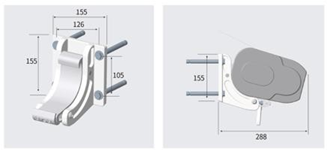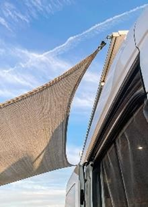Detail the connecting accessories of the awning to ensure the skills of stable installation
In the field of outdoor recreation and building protection, awnings play an indispensable role, it can not only protect us from the hot sun and wind and rain, but also add a unique beauty to the space. All the components, like the "bone joints" of the awning, work closely together to support the entire sunshade system and ensure its stable and reliable operation in different environments.
Types of Connecting accessories
Expansion screws: This is one of the most common accessories and is often used to attach the awning brackets or fixtures to the structure of the building's walls, floor, etc. It provides stable support by screwing in the screw after drilling the hole, causing the expansion tube to expand, thus securing it tightly to the matrix.
U-bolts: Generally used to connect the support of the awning to the beam or other structural component. Its shape is U-shaped, with threads at both ends, which can be tightened by nuts to firmly connect the two parts together, and it is often used in parts that require a strong connection.
Corner code: Corner code is usually used to connect the frame corners of the awning, which plays a role in fixing and strengthening the structure. It allows the frame to form stable right angles or other angles, enhancing the overall stability of the awning. There are different types of straight corner codes, bevel corner codes, etc., to suit different frame structures and installation needs.

Base: The base is the mounting base of the telescopic awning, connecting the wall and carrying the awning.

Canvas buttonholes and matching ropes or hooks: Canvas buttonholes are metal or plastic fittings that are installed on the edge of the awning canvas and used in conjunction with ropes or hooks to secure the canvas to the frame. The rope can be threaded through the buttonholes and tied, or a hook can be used to hook the buttonholes and pull the canvas tight and secure it, allowing the awning to be taut and kept flat.

https://www.stokeloafvan.com/blog-1/diy-van-awning-for-under-100
Tips for ensuring a solid installation
Measurement: Before installing the awning, it is necessary to take accurate measurements of the installation location, including the height and width of the wall, and the area where the awning needs to be installed, etc. Mark the location of holes, etc.
Check the wall or mounting surface: check whether the mounting surface is smooth and strong, and whether there are cracks, loosening and other problems. If the mounting surface is not level, you can adjust it using gaskets or caulk to ensure that the connecting fittings can be stressed evenly. For walls that are not sturdy, reinforcement treatments such as the use of reinforcement panels or the addition of support structures may be required.
Installation: installation requires more than two people, one person to install, one person responsible for lifting the awning and accessories, this is very important, must contact the helper in advance before installation, do not think about a person to complete the job.
To sum up, the connecting accessories of the awning, although small in size, play a decisive role in the entire awning system. From the strong anchorage of the expansion screws, to the strong connection of the U-bolts, to the synergy of accessories such as corner codes, bases, and canvas buttonholes, use the right firm mounting techniques.
https://www.dc-tent.com/Heavy-duty-Full-Cassete-Awning